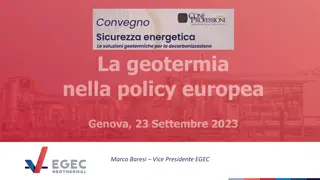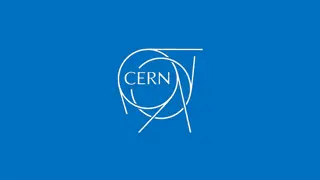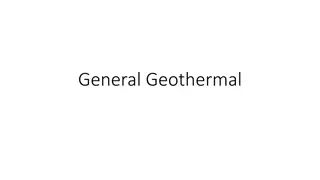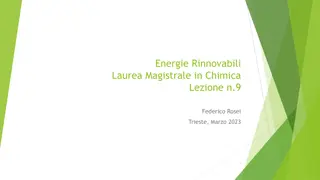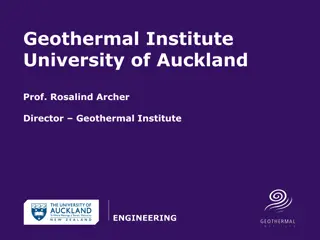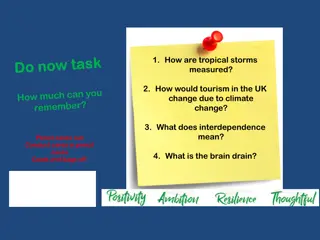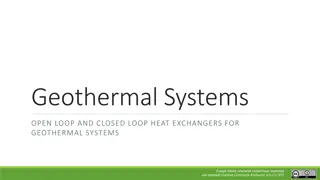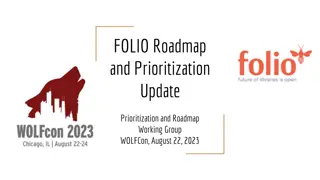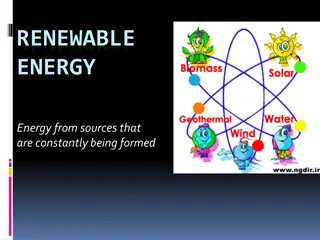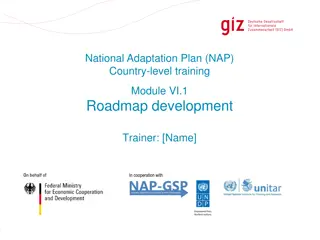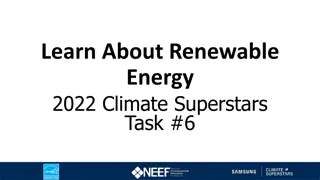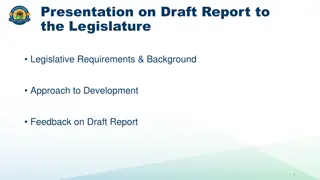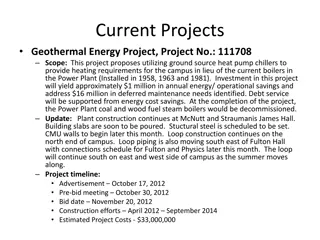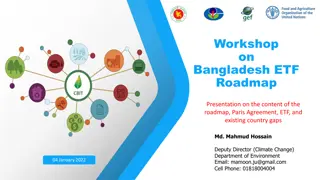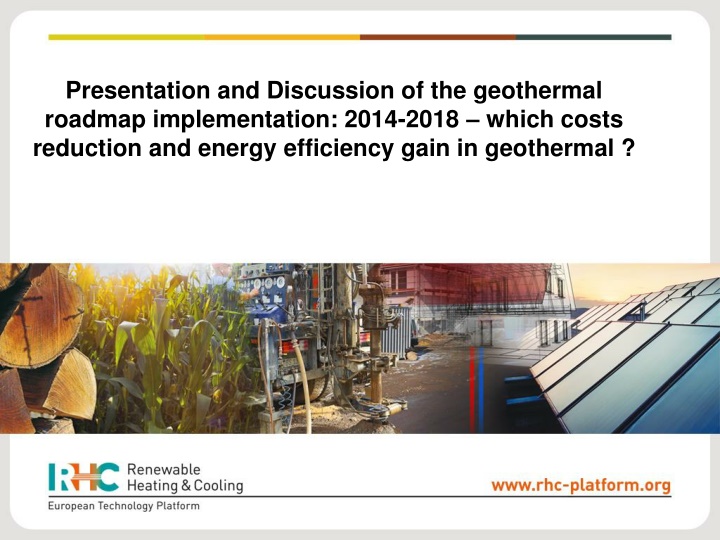
Geothermal Roadmap Implementations: Cost Reduction and Energy Efficiency Gains 2014-2018
Discover the detailed implementation plan and budget overview for the geothermal roadmap between 2014 and 2020. Explore the industry's investment in R&D, project status, and outcome in WPs 14-18. Learn about funding opportunities and the key developments shaping the geothermal sector.
Download Presentation

Please find below an Image/Link to download the presentation.
The content on the website is provided AS IS for your information and personal use only. It may not be sold, licensed, or shared on other websites without obtaining consent from the author. If you encounter any issues during the download, it is possible that the publisher has removed the file from their server.
You are allowed to download the files provided on this website for personal or commercial use, subject to the condition that they are used lawfully. All files are the property of their respective owners.
The content on the website is provided AS IS for your information and personal use only. It may not be sold, licensed, or shared on other websites without obtaining consent from the author.
E N D
Presentation Transcript
Presentation and Discussion of the geothermal roadmap implementation: 2014-2018 which costs reduction and energy efficiency gain in geothermal ?
Implementation plan 2014 - 2020 Geothermal technology roadmap Shallow geothermal technologies Deep geothermal technologies Ground Coupling Technologies Deep Geothermal Resources Resources, new systems and integration Deep Geothermal Drilling Deep Geothermal Production EGS Flagship Program 2
Budget overview to implement the geothermals SRA between 2014 and 2020 The total amount of R&D money spent by industry within Horizon 2020 (2014- 2020): Horizon 2020 and member states Around 400 Mio EUR Around 740 Mio EUR Total R&D investment needed between 2014 and 2020: 1140 Mio EUR
Implementation Roadmap 2020 Industry: ca 400 mio Status 2018 H2020: - EU contribution: 160,675 mio - Private contribution: 85 mio Budget Public (regional, national and European): ca 740 mio Geothermica (ERANET): 50mio , half public and half private funding around 300 mio + Industry, regional and other national instruments Number of projects 32 on deep GT 30 on shallow GT 36 projects co-funded by public money from H2020 calls on RES&EE, Industrial leadership ; from SME-instrument; from INTERREG and ERASMUS+. = a total of 62 projects co- funded by public money
What has been the outcome in the WPs 14-18? There have been a number of specific calls covering a number of topics mentioned in the roadmap. In competition with other RES technologies, Geothermal has been quite successful obtaining funding within H2020 The Commission through INEA is closely monitoring coordination and success of the different Projects Other interesting funding opportunities are available: ERA Cofund (ERANET Geothermica) EERA, NER300 (for commercial deep innitiatives) + National Research funding
Shallow geothermal // Summary of key conclusions State of Play in 2018 Total Installed Capacity in Europe: ca.23.000 MWth More than 1.8 million units
Largest borehole heat exchangers fields in Europe Country Country City, Name City, Name No. BHE No. BHE Depth BHE (m) Depth BHE (m) Total BHE (m) Total BHE (m) Year Year RO RO Magurele near Bucharest, ELI-NP Magurele near Bucharest, ELI-NP 1080 1080 125 125 135000 135000 2015 2015 CH CH Zurich, FGZ Wohnquartier Friesenberg Zurich, FGZ Wohnquartier Friesenberg 500 500 250 250 125000 125000 constr. constr. CH CH Zurich, ETH-Campus H nggerberg Zurich, ETH-Campus H nggerberg 425 425 200 200 85000 85000 constr. constr. FI FI ?, Shopping centre ?, Shopping centre 50000 50000 constr. constr. CH CH Wallisellen, Richti-Areal Wallisellen, Richti-Areal 220 220 225 225 49500 49500 2012 2012 SE SE Karlstad, Campus Karlstad Karlstad, Campus Karlstad 204 204 240 240 48240 48240 2014 2014 NO NO L renskog, Nye Ahus hospital L renskog, Nye Ahus hospital 228 228 200 200 45600 45600 FI FI Sipoo, SOK Logistics Centre Sipoo, SOK Logistics Centre 150 150 300 300 45000 45000 2012 2012 SE SE Lund, IKDC / Chemical Inst. Lund, IKDC / Chemical Inst. 165 165 230 230 37950 37950 CH CH Basel, Novartis Campus Basel, Novartis Campus 170 170 220 220 37400 37400 2012 2012 NO NO Oslo, office/flats Nydalen Oslo, office/flats Nydalen 180 180 200 200 36000 36000 SE SE Stockholm Saltsj baden, flats Stockholm Saltsj baden, flats 156 156 230 230 35880 35880 SE SE Stockholm, office Skanska Lustg rden Stockholm, office Skanska Lustg rden 144 144 230 230 33120 33120 2014 2014 CH CH Rotkreuz, Suurstoffi Rotkreuz, Suurstoffi 220 220 150 150 33000 33000 2014 2014 NO NO Bergen, Sartor Bergen, Sartor 162 162 200 200 32400 32400 2014 2014 150 150 32250 32250 2013 2013 DE DE L beck, IKEA D nischburg L beck, IKEA D nischburg 215 215
New KPIs COSTS REDUCTION Reduce costs for operating the geothermal heat pump system, leading up to 20% costs reduction of the O&M in 2020, and 30 % in 2030 (from 2014 value: 9430 per year, for a geothermal system capacity of 50 kWth in a new building, supplying heating at T = 35 C during 2200 h per year and cooling at T = 7 C during 1200 h, in western Europe climate conditions), assumed with stable energy prices (or statistically levelled). annual maintenance, control costs have decreased Performance improved so less electricity input Assume a 5% costs reduction of the O&M between 2014 & 2018 This should lead up to 10% costs reduction of the O&M in 2020, due to many R&D actions. But cost in is stable as electricity price rose. Reduce investment costs for a geothermal heat pump system, leading up to 20% costs reduction in 2020, and 30 % in 2030 (from 2014 value: 68 000 , i.e. 1360 /kW, for a geothermal system capacity of 50 kWth in a new building, supplying heating at T = 35 C during 2200 h per year and cooling at T = 7 C during 1200 h, in western Europe climate conditions) Assume a 5-10% costs reduction of the investment costs between 2014 & 2018 Drilling: reduction esp. in juvenile markets Materials: reduction of 5-10% Installation: reduction of ca 10% HP: reduction in mature markets 11
ENERGY EFFICIENCY GAIN Decrease the energy input for operating the geothermal heat pump system by 10% in 2020 and 25% in 2030 (from 2014 value: 44.6 MWh electric, for a geothermal system capacity of 50 kWth in a new building, supplying heating at T = 35 C during 2200 h per year and cooling at T = 7 C during 1200 h, in western Europe climate conditions, use a SPFheating of 4) Reduction by 2-3% from 2014 to 2018 in mature markets, more in juvenile markets A lot of expectations from ongoing RD&I Increase the overall impact of a reduced borehole thermal resistance, the Hellstr m-efficiency, from below 60% (in the nineties) to about 75% (2014) in state-of-the-art installations, to more than 80% in 2020 and 85% in 2030. ongoing R&D 12
ENERGY EFFICIENCY GAIN Increase value of Seasonal Performance Factor in the order of 4.5 for 2020 and 5 for 2030 (from 2014 value: SPFheating average of 4, for a geothermal system capacity of up to 50 kWth, supplying heating and DHW at T = 35 C, in western Europe climate conditions) some increase, disparity of results Increase value of Seasonal Performance Factor in the order of 5 for 2020 and 5.5 for 2025 (from 2014 value: SPFheating average of 4.5, for a geothermal system capacity of 50-100 kWth, supplying heating at T = 35 C, in western Europe climate conditions) few systems, many achieved SPF 5. Increase value of Seasonal COP (SCOPcooling) in the order of 5 for 2020 and 5.5 for 2025 (from 2014 value: SCOPcooling average of 4.5, for a geothermal system capacity of up to 100 kWth, an active HP supplying cooling at T = 7 C, in western Europe climate conditions) idem Free cooling: Increase value of Seasonal COP (SCOPcooling) in the order of 22 for 2020 and 25 for 2025 (from 2014 value: SCOPcooling average of 20, for a geothermal system capacity of up to 100 kWth, free-cooling supplying cooling at T = 18 C, in western Europe climate conditions) idem 13
OTHER FACTORS The GIS Database have to consider geomechanical and thermal properties, as well as other factors, to transform static GIS systems in Decision Support Systems. In this way the GIS can help in selecting, for each location, the best combination between the dimensions of the borehole heat exchanger and of the drilling machine, reducing the uncertainty, minimizing the costs, maximize the environmental protection and the safety for the workers. no RD&I Increase number of installations in the EU per year to 150,000 units/y in 2020, to more than 200,000 in 2025, compared to 100,000 units in 2014. around 110,000 units in 2018 Still low percentages Percentage of the number of new installations compared to the number of new buildings at the city levels. But increase number of large installations Percentage of the number of total installations compared to total buildings at the city levels
Assesment of the period 2014-18 GEOTecH CHEAP-GSHP GABI Cost Action GEOCOND
GEOFIT GEO4CIVHIC GEOTABS TESSE2b GSS-VET GRETA GEOATLANTIC GeoPLASMA

